Wyandottes are impressive, beautiful, and generally healthy birds, and a breed that is a true North American original, first developed in the late 19th century.
Although it fell from popularity significantly during the middle part of the 20th century, these chickens are once again being recognized for their excellent all-around characteristics.
Accordingly, their popularity is climbing and happily, they’ve been taken off the endangered list by the American Livestock Conservancy.
And for backyard keepers and homesteaders, one of the best things about the breed is all the many colors that they come in. No matter what your favorite type of plumage, odds are pretty good that Wyandottes will make you happy.
To help you hone in on your new favorite strain of this venerated breed, I’m bringing you a full list of Wyandotte colors that you should know…
APA Recognized
The following variations are recognized by the American Poultry Association. If you want chickens that will conform to official guidelines for any purpose whatsoever, it’s got to be one of the following.
Note that one of the colors is only accepted for bantam variety Wyandottes, and is indicated accordingly.
Buff
Buff is best described as an even, all-over pale yellow or orange color. A buff Wyandotte that strictly adheres to this color variation won’t have any streaks, stripes, or patches of any other color. Note that even roosters will be entirely buff, with no contrasting markings or tail feathers.
Baby chicks will hatch and are nearly the same color that they will be when they are adults, although they usually have a distinct lighter patch on their breasts and belly, or they’ll be predominantly yellow before they darken upon feathering.
Blue
Blue Wyandottes are remarkably attractive, and also pretty rare, owing to a specific genetic combination required to produce them and they don’t breed true. The color of their plumage is a type of slate or iron gray color, and it might be as light as a pale pastel blue.
Note that some Wyandotte chickens that are properly classified as blue might look like a more common gray color. That’s just the way it is, this one is pretty variable.
Blue chicks are usually an even, medium gray-blue color upon hatching, and again often seen with sharply contrasting light-colored spots. These spots disappear once they feather.
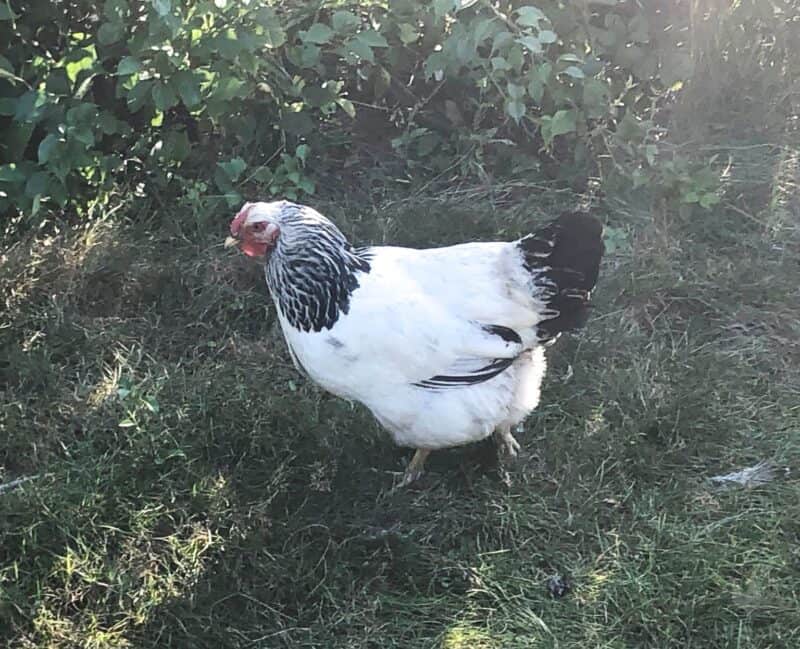
Columbian
My personal favorite variety, and certainly one of the most photogenic, is Columbian. These Wyandottes are white all over and have black accent colors at the ends of the tails, wings, and a patch on their necks. Roosters are particularly striking and often have darker accent markings and slightly larger patches compared to hens.
Columbian chicks differ significantly at birth: often they are yellow with ashy patches where the black will grow in later, though they may be white.
And once again, once they feather fully the colorful areas will disappear to be replaced by the standard white and black- assuming that they have bred true!
Buff Columbian (Bantam Only)
The Buff Columbian variation is APA accepted only on bantam Wyandottes, and as you’re probably already guessing, is a combination of buff and Columbian plumage.
They will have the golden, light yellow, or pale orange of the buff variety with the black rally markings on the tails, wingtips, and neck as with the standard Columbian.
Chicks look very much the same, but their black coloration will not be as dark or as large in proportion compared to the adults. If you see that buff color upon hatching, they are correct.
White
No surprises here, white Wyandottes are white. That’s it. A smooth, perfect, cottony white from front to back.
But as pedestrian as this color might be, you should know that white Wyandottes are among the rarest out there, so if you’ve got some consider yourself lucky! White Wyandotte chicks will hatch either white right out of the shell or else the well-known yellow.
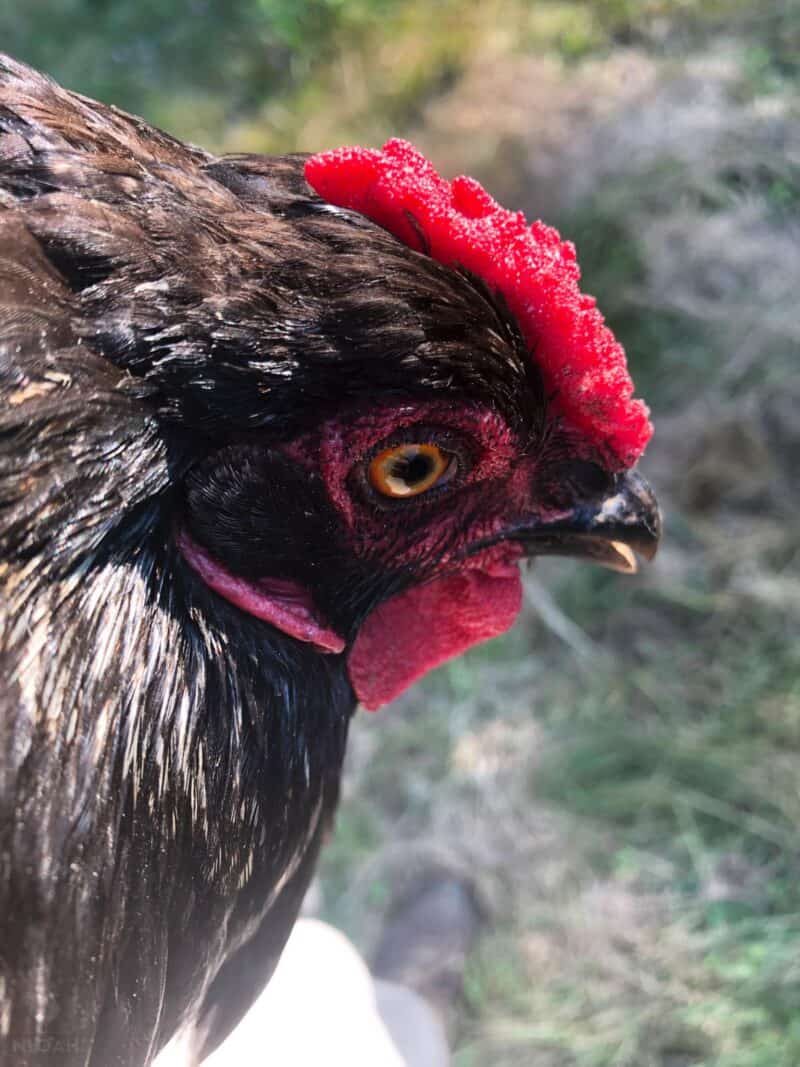
Black
Black Wyandottes are striking and delivering chickens, but not a variation you see too often. They will be pure black, black like coal, from beak to tail feather and the fringes will show some blue or blue-green iridescence in the sunlight.
They can be a great choice if you want a little protection from birds of prey, because many hawks and other predators might confuse them for large crows or ravens, a known deterrent.
Black Wyandotte chicks come out of the shell black, but not black all over; they will have patches of lighter down.
Partridge
The partridge variation is another iconic plumage color and consists of an orange buff color as a base with dark, distinct stripes or markings near the ends in the edges, known as penciling. The overall pattern and location of the patches of marked feathers can vary somewhat.
And here we see a major difference between roosters and hens: roosters have dramatic, impressive jet-black tails with the same shimmery, iridescent green highlights seen on black Wyandottes, while their heads and necks tend to be significantly paler than the rest of their body, a true buff color.
Chicks are quite plain, being a dark tan color with a few darker patches. They darken significantly upon feathering.
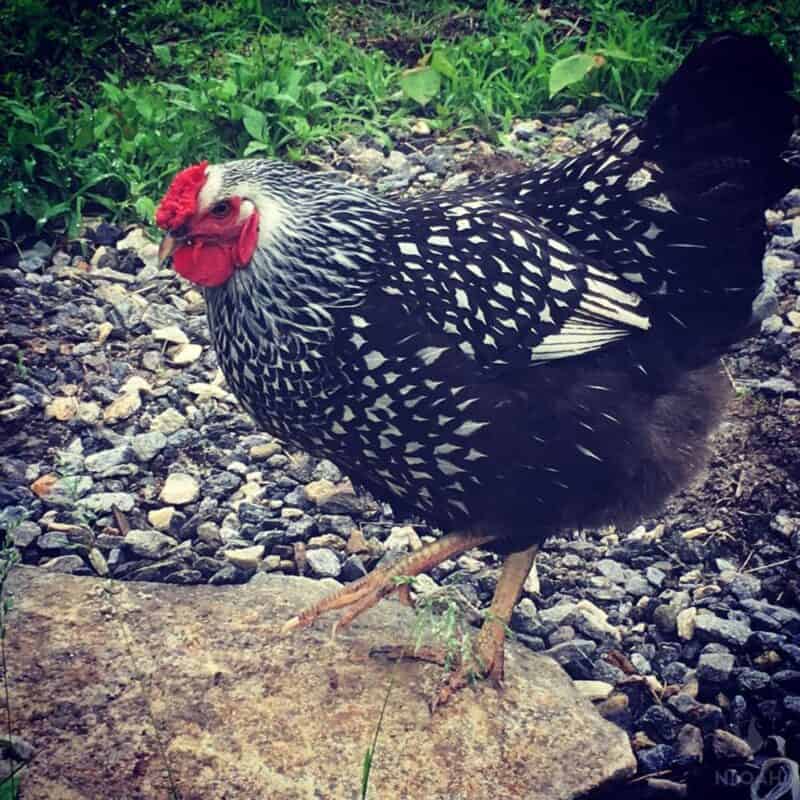
Silver-Laced
Another stunning variety, silver-laced Wyandottes have a regal and reserved look that’s sure to please even the pickiest chicken fancier.
The base color is white, and on the back and sides of the neck, head, and body feathers will be outlined in a matte black. The thighs, underside, and tails are all jet black, and often show iridescence.
Silver-laced chicks will hatch in all sorts of different colors, including an ashy white, yellow, black, and various shades of gray. Don’t worry, that beautiful pattern will kick in as they mature, I promise!
Silver-Penciled
You might think of a silver-penciled Wyandottes as a sort of pallet swap of the partridge variety above: instead of that toasted orange base color, they are what and have the same patches of pencil stripes, only this time in a matte black that is more consistent with the silver color.
And like the partridge variety, roosters diverge significantly from that of hands, having much larger patches of black on their tails and wings, and fewer penciled markings elsewhere.
Chicks usually pop out of the shell in a pale yellow color, but will start showing development of these stripes along their wings and elsewhere on their body at about two and a half weeks of age.
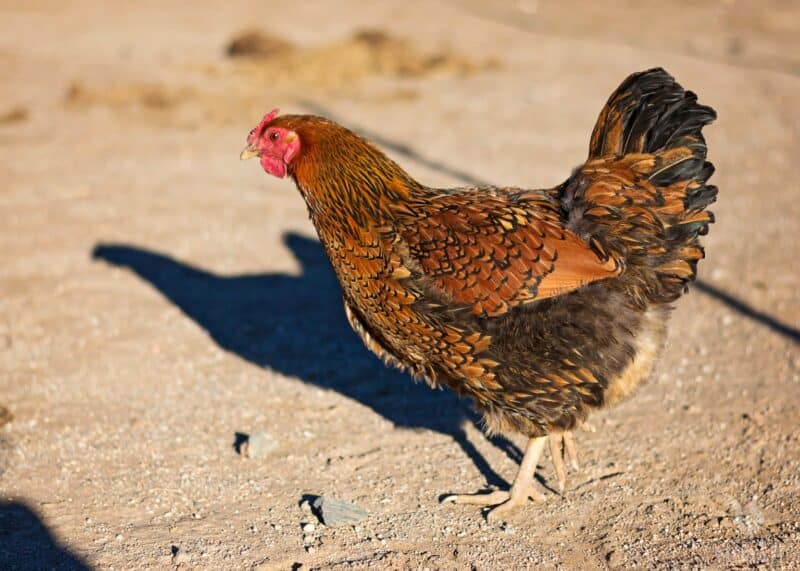
Golden Laced
A drop-dead, knockout gorgeous Wyandotte variety, golden-laced birds have a rippling, shifting gold base color across all of their feathers that can be more of a copper on the breast and a pale, shiny sienna color on the neck and back.
Each feather will be outlined and tipped in a dark black, with some feathers being predominantly or entirely black near the ends of the wings and tail. These are fantastically good-looking Wyandottes, let me tell you!
But it is a case of the ugly duckling, or ugly chick you might say: chicks don’t look as impressive while they are small, and are usually a mottled brown, gray, and tan. Don’t be disappointed, because once those feathers come in, they’ll be showstoppers!
Non-APA Recognized
The following Wyandotte colors are genuine ones that have been around a while, not designer ones more recently produced by backyard breeders and hatcheries, but they simply are not recognized by the APA as standard in the United States. Some of these are officially recognized in the UK, France, or elsewhere in Europe, however…
Barred
You’ve probably seen the adorable barred variation on the Plymouth Rock breed, but Wyandottes have exactly the same color and pattern. It consists of alternating, slightly offset, stripes of white and black from head to tail.
They look a little bit like zebras, and believe it or not this pattern can actually help free-ranging Wyandotte stay a little bit safer from predators because it provides them some camouflage.
Even more surprising, chicks do come out of the shell with stripes, but not all over their body, and their colors are muted, usually gray and white. Their stripes will intensify in color and cover their bodies as they age.
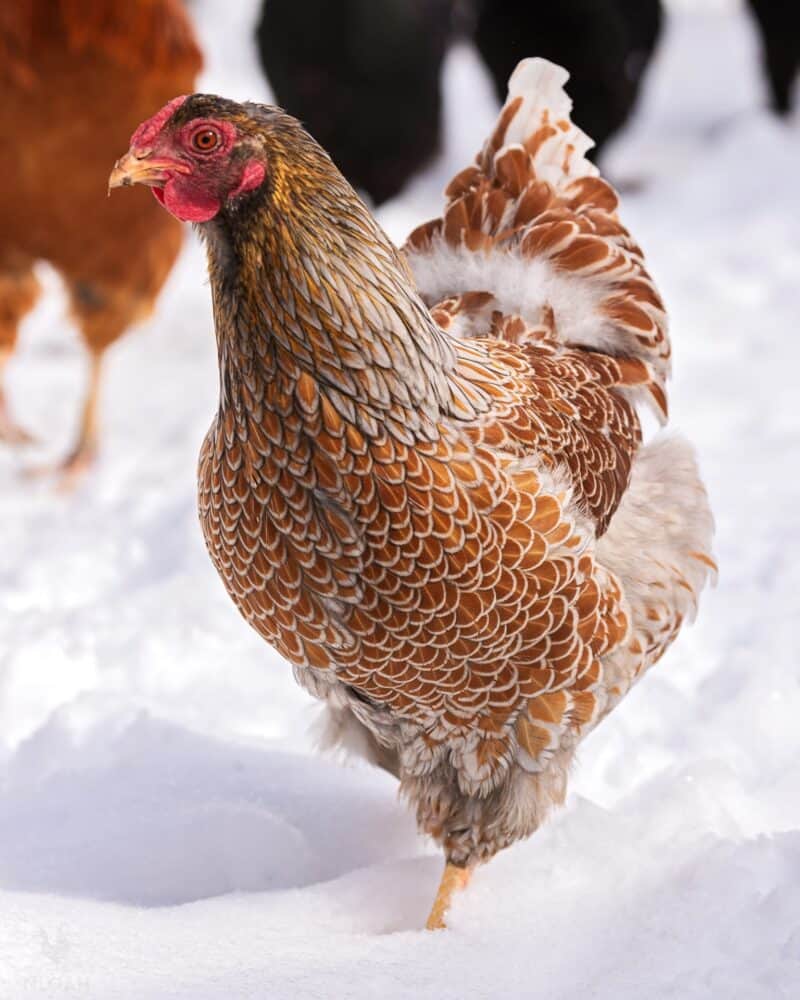
Blue-Laced
Another truly striking color, blue-laced Wyandottes have a steely blue base color with an even darker blue or black lacing on the edges of each feather. This gives them a rippling, dark coloration that looks almost like scales. Very unique, and highly attractive!
Chicks are typically born with lighter patches in various places on their bodies, and no discernible pattern. As their adult feathers come in, you’ll see that pattern emerge.
Blue Partridge
Another striking and unique type of plumage is blue partridge. It’s very uncommon, though not unheard of in the United States. Blue Partridge consists of a blue base color replacing the burnt orange of the usual partridge, and patches of very dark blue or black pencil markings.
As is typical with all of the partridge variations, roosters have much lighter feathers towards the head and huge, dark ,a nd impressive tail feathers and wing patches. Chicks are born medium to dark blue with contrasting darker patches.
Buff-laced
Another super-sharp Wyandotte variation that’s sure to impress, buff laced is exactly what you’re anticipating by now: The base color is a toasty, chestnut buff color outlined by pale gray or white edges.
Undersides, the base of the neck and the rump are often pure white with a few thin patches of the base color. Gorgeous! Another favorite I greatly enjoy, but I tend to say that about all Wyandottes.
Buff-laced chicks are born yellow or plain buff, though you’ll see some toasted brown markings on their extremities which will darken and spread as they grow. Note that they do not have white fringes at all while they are young.
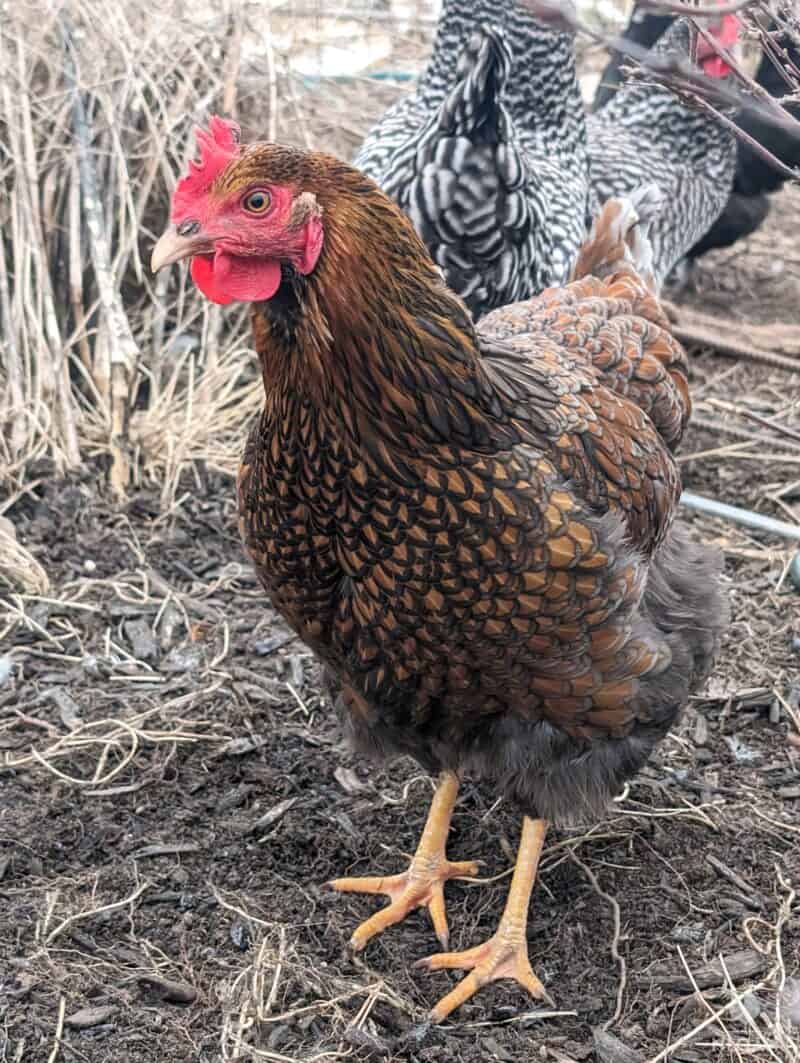
Red
A typical rusty red, with some brighter red patches. That’s it. The color is uniform if on a slight gradient over their entire body. Uniformity except for slight shading is the rule for a true red Wyandotte.
Chicks are born buff or light brown, and their feather color deepens significantly as they age.
Mille Fleur
Mille Fleur is a super fancy pattern, and in the original French stands for “thousand flowers.” A name that will become obvious as soon as you lay your eyes on these indescribably gorgeous Wyandottes!
The base feather coloration is an even, medium red-brown, accented by a stunning pattern of randomized white and black bands at the ends of the feathers. It really does look like they are covered in little blooms!
Mille fleur chicks are born dark brown or black with accenting patches of white or a pale, lemon yellow. Compared to adults, their coloration is more uniform with the chest and underside being lighter and the back, head, and tail being darker.
Blue-Laced Red
And last but certainly not least on our list, blue-laced red Wyandottes combine some of the most remarkable colors you’ll see on any chicken into one package.
There are feathers that are red throughout, as with the red variety above, but have the laced edges in a dark, stony blue. This is another gorgeous variation, and genuinely dramatic!
Most remarkably, this is the only Wyandotte variation that might be called self-sexing: when the girls hatch, they tend to be much lighter overall compared to the boys, with only a few dark patches on their mostly white or pale yellow bodies.
The boys, conversely, have darker chests, abdomens, and heads, usually a brown or gray color…
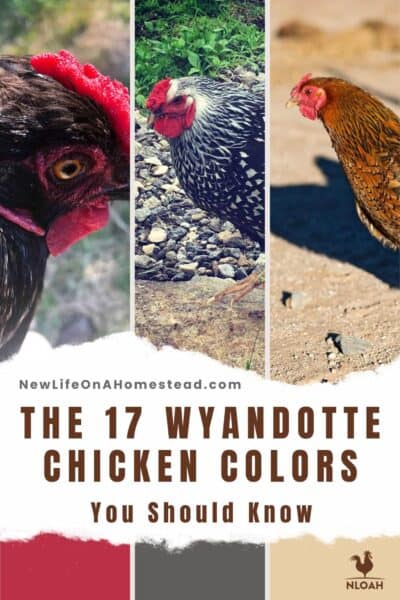
Tom has lived and worked on farms and homesteads from the Carolinas to Kentucky and beyond. He is passionate about helping people prepare for tough times by embracing lifestyles of self-sufficiency.
